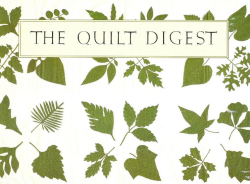by Patricia Belyea
SAN FRANCISCO CA Roderick Kiracofe, once a quilt dealer, now a quilt collector, beams when he talks about his newest book Unconventional & Unexpected: American Quilts Below The Radar 1950-2000.
An author who’s written or co-written umpteen books on quilts, Roderick is best known for his tome “The American Quilt, A History of Cloth and Comfort 1750-1950.” This book stands out because of its comprehensive overview of American quilting during its formative years.
So the sequel, “Unconventional & Unexpected,” moves forward in time to the last half of the 20th century. It’s releasing on September 9, just in time for the Giving Season.
Visiting Roderick’s classic townhouse in the Noe Valley, where he lives with his husband Jack, I was quickly able to discern where he came up with the title of his new book. Eclectic, with every square foot packed with collections of treasures, their home reflects an appreciation of all things intriguing and heartwarming.
While making us tea, Roderick described how he and Michael Kile as young men started buying quilts in Ohio. They purchased quilts they could afford while the ones they really wanted were out of their reach.
A friend suggested to Roderick and Michael that they sell their quilts. Their first reaction was “No!” but they reconsidered. As virgin dealers, they went to an antique show in Albion, Michigan—where they didn’t sell a thing.
That effort introduced them to an old-timer who suggested they apply to sell at Ann Arbor Antiques Market. Amazingly their first time at this long-standing, once-a-month market landed them in one of the main buildings, not the animals stalls on the perimeter of the action. They sold out—over 30 quilts—that day.
Roderick and Michael included all the known information about each quilt with every purchase—Pattern Name, Size, Fabrics and Description—typed up on a piece of paper. This differentiated them from other dealers at the time and gave them an aura of being experts.
Enthusiastic and full of energy, Roderick and Michael built a network of suppliers on the East Coast and throughout the Midwest. They attended farm auctions and worked with antique dealers to build a continually revolving inventory for their small business.
When Roderick and Michael moved to San Francisco in 1978, they found retail dealers in San Francisco and LA were interested in everything they could deliver. Kiracofe and Kile, based in an ornate Victoria home on a tree-lined street of Dubuce Triangle, featured American Quilts. Nothing was held back—all the finest they could buy, they sold.
Roderick and Michael began their publishing careers in 1983 with The Quilt Digest. The superbly designed annual publication told in-depth stories of quilts and their makers, as well as displayed antique and contemporary quilts.
Ultimately the partners split up, each moving forward on different orbits of the quilt universe. Roderick continued to be involved with books and calendars that brought his love of quilts to the public eye. He also built a career in real estate and development that included planting seeds for the arts district in Oakland.
Twelve years ago, Roderick woke up one morning with an epiphany. He was ready to put together a collection of quilts—for himself. Ones that appealed to his eye and his aesthetic. His focus would be quilts made after 1940. This time when he went to buy quilts, most of the players had changed and eBay had joined the scene.
Right there in his storytelling, Roderick stood up and said “Let’s go out to the Quilt Barn.” I assumed this was an euphemism for a shed or garage filled with quilts. No so. Unexpectedly, across Roderick’s backyard stood a traditional milk barn. Roderick explained that Noe Valley supplied San Francisco with its dairy products many years ago.
Learning that Roderick rarely brings guests out to his Quilt Barn, I felt honored to be invited through its yellow door.

Inside huge piles of quilts lay under white cotton bedsheets. In the center of the space, a standing cupboard revealed shelves of vintage flimsies awaiting their fates—would they ever be stitched into quilts? At the far end, a folding table disappeared under stacks of folded quilts. Surrounded by his eccentric collection, Roderick talked more about his new book. “Unconventional & Unexpected” includes 200 of his quilts, made predominately by anonymous quilters, and essays by renowned experts.
There on the counter lay the printer’s proof—a beautifully designed hardcover book published by Stewart, Tabori & Chang (a division of ABRAMS). Roderick told me I was the fourth person to see it. I felt inspired as I flipped through the pages filled with extraordinary quilts.
Roderick and I could have kept chatting but he had to pack for a major trip to the East Coast the very next day. We wrapped up with a promise to stay in touch as we recognized each other as fellow quirky quilt devotees.
To visit Roderick’s website +click here








